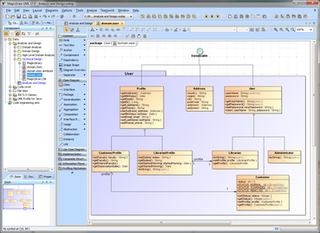Motivating example
Enterprise systems based on multiple domain-specific languages are abundant. Languages with a metamodel defined in the Extensible Markup Language (XML) enjoy particularly widespread adoption. To illustrate development with multiple languages, we will draw an example from a case study: The Apache Open For Business (OFBiz) system. Briefly stated, OFBiz is an enterprise resource planning system that includes standard components such as inventory, accounting, e-commerce etc. These components are implemented by a mixture of XML-based languages and regular Java code. As an example, let us focus on the content management component, particularly a use case in which the administrative user creates an online web survey as shown in the screenshot below. We will refer to this example as the create survey example.
The figure shows a screenshot of the administrative interface of the content management application in a running OFBiz instance. To create a survey, the user fills out the fields of the input form and hits the update button. This creates a new survey which can be edited and later published on a frontend website in OFBiz. Behind the scenes, this use case involves several artifacts written in different languages. In this example, let us focus on only three of these languages: the Entity, the Service, and the Form DSL.
These three languages correspond roughly to the structural, the behavioural, and the user interface concern in OFBiz. The Entity DSL is used to describe the underlying data model and hence the way the created survey will be saved. The Service DSL is used to describe the interface of the service that is invoked when the user hits the update button. Finally, the Form DSL is used to describe the visual appearance of the form. Although the three languages are tailored for different things, they can not be separated entirely. The user interface invokes a certain application logic and this application logic manipulates the data of the application. This is an example of non-orthogonal concerns. The languages overlap because the concerns that they represent cannot be separated entirely. Let us examine these three languages in a bottom-up manner and point out their overlaps.
Entity DSL
The Entity DSL defines the structure of data in OFBiz. The listing below shows the definition of the Survey entity which is the business object that represents the concept of a survey. The code in the Listing is self-explanatory: An entity called Survey is defined with 10 fields. Each field has a name and a type. The field surveyId is used as the primary key. This definition is loaded by a central component in OFBiz called the entity engine. The entity engine instantiates a corresponding business object. The purpose of the entity engine is to manage transactional properties of all business objects and interact with various persistence mechanisms such as Java Database Connectivity, Enterprise JavaBeans or even some legacy system.
<entityentity-name="Survey"...title="Survey Entity"><fieldname="surveyId"type="id-ne"/><fieldname="surveyName"type="name"/><fieldname="description"type="description"/><fieldname="comments"type="comment"/><fieldname="submitCaption"type="short-varchar"/><fieldname="responseService"type="long-varchar"/><fieldname="isAnonymous"type="indicator".../><fieldname="allowMultiple"type="indicator".../><fieldname="allowUpdate"type="indicator".../><fieldname="acroFormContentId"type="id-ne".../><prim-keyfield="surveyId"/></entity>Service DSL
The Service DSL specifies the interface of the services in OFBiz. Each service encapsulates part of the application logic of the system. The purpose of this language is to have a uniform abstraction over various implementing mechanisms. Individual services can be implemented in Java, a scripting language, or using a rule engine. The listing below shows the interface of the createSurvey service.
Apart from the name, the service element specifies the location and invocation command of the implementation for this service. The default-entity-name attribute specifies that this service refers to the Survey entity which was defined in the previous listing. This is an overlap between the two languages, specifically a so-called soft reference. A model in the Service DSL refers to a model in the Entity DSL. This reference is used in the two auto-attributes elements below which specify the input and output of the service in the form of typed attributes. As input, the service accepts attributes corresponding to all non-primary key (nonpk) fields of the Survey entity and these attributes are optional. As output, the service returns attributes corresponding to the primary key (pk) fields of Survey, i.e., in this case the surveyId field, and these attributes are mandatory. The purpose of the reference across languages is in this case to reduce redundancy. The attributes of the createSurvey service corresponds to the fields of the Survey entity and it is therefore only necessary to specify them once.
<servicename="createSurvey"default-entity-name="Survey"...location="org/ofbiz/content/survey/SurveyServices.xml"invoke="createSurvey">... <permission-serviceservice-name="contentManagerPermission"main-action="CREATE"/><auto-attributesinclude="nonpk"mode="IN"optional="true"/><auto-attributesinclude="pk"mode="OUT"optional="false"/></service>Form DSL
The Form DSL is used to describe the layout and visual appearance of input forms in the user interface. The language consists of domain concepts such as Form and Field. The listing below shows the implementation of the EditSurvey form. This time the Form DSL overlaps with the Service DSL. The target attribute of the form and the alt-target elements specify that the input from the submission of this form should be directed to either the updateSurvey or createSurvey services. The auto-fields-service element specifies that the form should include a field corresponding to each of the attributes of the updateSurvey service (which are similar to the attributes of the createSurvey service). This produces a similar effect of importing definitions from another model as in the case of the auto-attributes elements in the previous listing. Further down, we can see that it is possible to customize the appearance of these imported fields such as isAnonymous. Finally, a submitButton is added with a localized title such that the user can submit his data to the referenced service.
<formname="EditSurvey"type="single"target="updateSurvey"title=""default-map-name="survey"><alt-targetuse-when="survey==null"target="createSurvey"/><auto-fields-serviceservice-name="updateSurvey"/><fielduse-when="survey!=null"name="surveyId".../>... <fieldname="isAnonymous"><drop-downno-current-selected-key="N"allow-empty="false"><optionkey="Y"/><optionkey="N"/></drop-down></field>... <fieldname="submitButton"title="${uiLabelMap.CommonUpdate}"widget-style="smallSubmit"><submitbutton-type="button"/></field></form>The create survey example, as described here, is implemented using models in three different languages. The complete implementation actually involves even more languages such as a Screen DSL to specify the layout of the screen where the form is placed, and a Minilang DSL which is a data-manipulation language used to implement the service. However, these three languages do illustrate the main idea of making each concern concrete. The example also shows a simple way of reducing redundancy by letting the languages overlap slightly.
Multi-level customization
Domain-specific languages, like those described above, have limited expressiveness. It is often necessary to add code snippets in a general-purpose language like Java to implement specialized functionality that is beyond the scope of the languages. This method is called multi-level customization. [2] Since this method is very commonly used in setups with multiple languages, we will illustrate it by a continuation of the example. Let us call this the build PDF example.
Suppose we want to build a PDF file for each survey response to the online surveys that users create. Building a PDF file is outside the scope of our languages so we need to write some Java code that can invoke a third-party PDF library to perform this specialized functionality. Two artifacts are required:
First, an additional service model, as shown below, in the Service DSL that defines the interface of the concrete service such that it can be accessed on the modeling level. The service model describes the location of the implementation and what the input and output attributes are.
<servicename="buildPdfFromSurveyResponse"engine="java"location="org.ofbiz.content.survey.PdfSurveyServices"invoke="buildPdfFromSurveyResponse"><attributename="surveyResponseId"mode="IN"optional="false".../><attributename="outByteWrapper"mode="OUT"optional="false".../></service>Second, we need a code snippet, as shown below, that contains the actual implementation of this service. A service can have multiple inputs and outputs so input to the Java method is a map, called context, from argument names to argument values and returns output in the form of another map, called results.
publicstaticMapbuildPdfFromSurveyResponse(DispatchContextdctx,Mapcontext){Stringid=(String)context.get("surveyResponseId");Mapresults=newHashMap();try{// ...the response is retrieved from the database...// ...a pdf is built from the response...// ...the pdf is serialized as a bytearray...ByteWrapperoutByteWrapper=...;results.put("outByteWrapper",outByteWrapper);}catch(Exceptione){}returnresults;}This multi-level customization method uses soft references similar to the create survey example. The main difference is that the reference here is between model and code rather than between model and model. The advantage, in this case, is that a third-party Java library for building PDFs can be leveraged. Another typical application is to use Java code snippets to invoke external webservices and import results in a suitable format.








